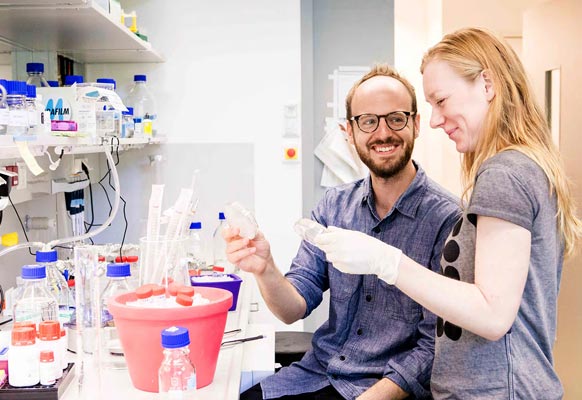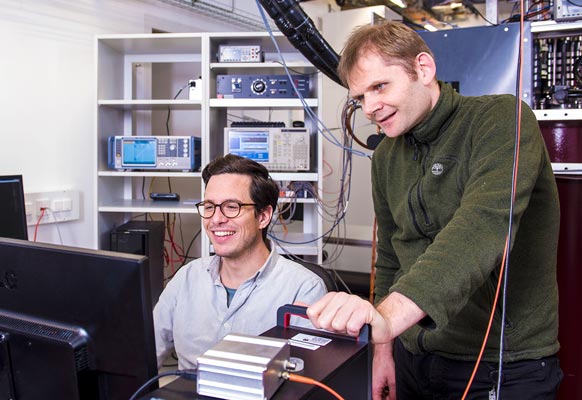April 8, 2021
How to Become a Professor at IST Austria
Finding a permanent position in science is hard, but IST Austria provides a system that enables long-term planning.

© Nadine Poncioni / IST Austria
In a career in academia few things stay the same for long. Scientists change their workplace every few years, and with it often also the city or even the country they live in. While this can be exciting, it also puts stress on the long-term planning of research projects and personal life. The Institute of Science and Technology Austria (IST Austria), wants to improve that with its own system for becoming a professor.
Becoming an established scientist can be a wild ride. Scientists are excited about their field of research and its challenges, be it human cells or quantum computers, but the more mundane aspects of career planning can also create difficulties. Many positions in current systems of academia are only temporary and finding a permanent position as a professor can be very difficult.
The Institute of Science and Technology Austria (IST Austria) uses a so-called “tenure track” system of attaining professorship that combines scientific freedom with security in planning a career. Martin Loose and Johannes Fink have just completed this step and are now full professors at IST Austria. For both of them it has been a long way to this permanent position.

© Roland Ferrigato / IST Austria
Always on the Move
After studying in an undergraduate and graduate program, most scientist continue with several short postdoctoral positions at different institutions. “After my PhD and a short postdoc in Dresden, I moved to the U.S. for another postdoc at the Harvard Medical School before coming to IST Austria”, Martin Loose recounts his career. “While holding a temporary position, you quickly start thinking about the next one and it becomes harder to fully focus on the current research project.”
Johannes Fink had a similar experience. He first studied physics in Vienna and then moved on to ETH Zurich in Switzerland for his master’s thesis, a PhD, and a postdoctoral position. “Both at ETH Zurich and later for a postdoc at Caltech, I was part of a group that was building a new research environment,” he says. “I was glad that I could contribute to building something there, but when I had to leave for my next position I missed out on the benefits of the long-term planning of and investment in scientific facilities and teams.”
While temporary positions in academia encourage scientists to move around the world and gather new experiences, it poses difficulties for long-term investments in both their professional and personal life. Moving to another city or even country can put stress on the scientists and their families that have to readapt each time, often to a new culture and language.
On Track to Professorship
IST Austria’s tenure track system combines elements from both the American and the European academic career systems. A researcher has achieved “tenure” when they attain a permanent position and the “tenure track” leads there. They start as Assistant Professor and after six years of research, they are evaluated by a committee of international experts in their field and can achieve a permanent position as a Professor.
One special feature of this system in contrast to more traditional Austrian academic systems is that scientists on the tenure track are very independent in their research with their own research groups from the very beginning. Some other institutions both in Austria and around Europe are also adopting the American tenure track system. However, in many places several Assistant Professors have to compete for one professorship. At IST Austria, each Assistant Professor gets the chance to gain full professorship. The selection for excellence in research already takes place at the application level for tenure track positions.
This system allows junior group leaders to focus on a long-term perspective in both their research and their personal life. For many, this is a major bonus when selecting a new position. Martin Loose confirms, “The tenure track system and its focus on long-term planning at IST Austria was one of the reasons I chose it.” Johannes Fink concurs, “After working in the U.S., I wanted to come back to Europe and the independence and responsibility you get early on at IST Austria was very attractive.”
IST Austria wants to strengthen scientists in their work to achieve a healthy and productive environment and to enable excellent research. While there still remain problems with the system of temporary positions at all career levels in academia, the tenure track system at IST Austria adapts aspects from both the European and the American systems to create the best possible research environment. It enables researchers to focus on their work and offer an attractive environment for their families.
64 group leaders started at IST Austria. Among them:
18 group leaders on a tenured position (Professor).
46 group leaders on a tenure track position (Assistant Professor).
19 Assistant Professors were already promoted to Professor.
The mean duration of a tenure track position is about 5 years.
The youngest Assistant Professor began her tenure track position at age 28 and the youngest candidate with a positive tenure evaluation was 34 years old.



